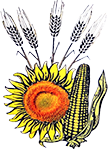The Experimental Results Regarding the Control of Weeds
Present in the Wheat Crop - NARDI Fundulea
Mihaela Şerban, Gheorghe Măturaru, Elena Partal
Institutul Național de Cercetare-Dezvoltare Agricolă
Keywords: weeds, herbicides, time of application, selectivity and efficacy.
Abstract: Wheat, which is one of the basic nutrients of humans, is the most cultivated crop in the world among cereal crops. It is an important crop affected by many weeds which, fortunately, can be effectively controlled by herbicide treatments. Herbicides must be correlated with the degree of weed infestation, the spectrum and dominance of weeds, the time of application, the technical potential of effectiveness, the local climatic conditions.
This paper presents the results obtained at the Fundulea National Agricultural Development Research Institute, from the period 2022-2023, according to the application of the new herbicide treatments: Floramix (70.8 g/kg piroxsulam + 14.2 g/kg florasulam + 70.8 g/kg cloquintocet-mexil (safener ) + Dasoil 26-2 N (Adjuvant); Pallas 7.5% piroxsulam + 7.5% cloquintocet-mexil – safener) + Adjuvant; Omnera (fluroxypir 135 g/l + thifensulfuron methyl 30 g/l + metsulfuron methyl 5 g/l) + Foxtrot 69 EW (fenoxaprop-P-ethyl 69 g/l + cloquintocet mexil 34.5 g/l - safener) and Pixxaro Super (12 g/l halauxifen-methyl + 280 g/l fluroxypyr meptil + 12 g/l cloquintocet-mexil), applied post-emergence for weed control. The purpose of the research was to combat the weed species present in the wheat culture by applying herbicide treatments, with the objective of widening the control spectrum, synergism, persistence and without negative impact on the environment.
